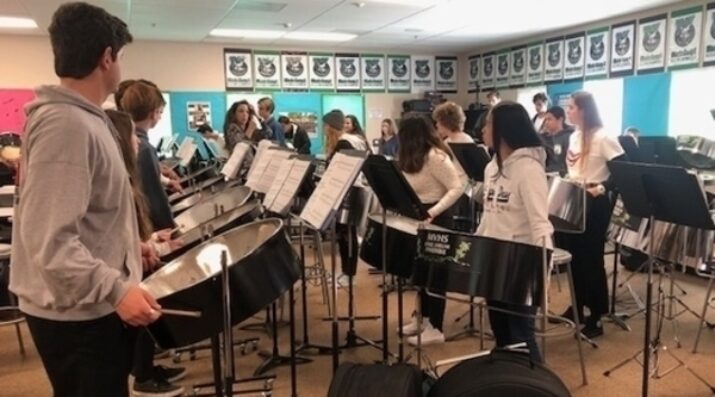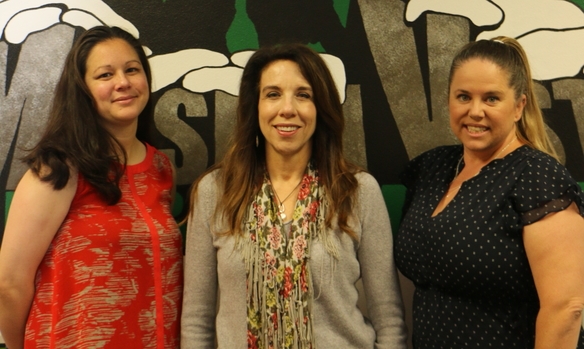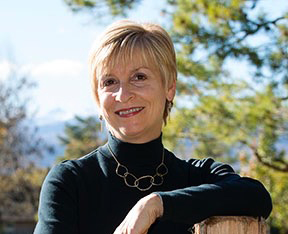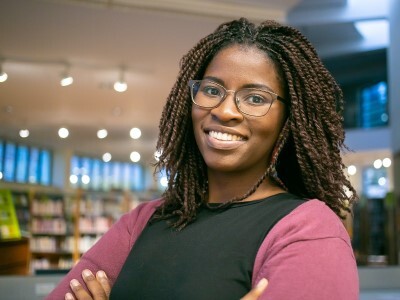Next Gen Change: Stories from Three Educators
Topics

Next generation learning is all about everyone in the system—from students through teachers to policymakers—taking charge of their own learning, development, and work. That doesn’t happen by forcing change through mandates and compliance. It happens by creating the environment and the equity of opportunity for everyone in the system to do their best possible work.
Practitioner's Guide to Next Gen Learning
Three classroom educators describe how they applied a schoolwide goal to personalize learning to their own teaching this past year.
What happens when school leaders trust and support educators to own the transformation of student learning?
This edition of Friday Focus: Practitioner's Guide to Next Gen Learning is the second of a two-part series about Mission Vista High School in Vista, Calif., and its work to design and integrate personalized, student-driven learning throughout the school's magnet program. Vista Unified School District is one of the districts Next Generation Learning Challenges has engaged with to explore, unpack, and document what next gen change looks like in real learning communities across the nation.
Last month's installment explored the ways that MVHS's approach to transforming learning embodies core practices of change management: finding both collective and personal why's for change, co-creating a shared vision to guide the change, and conferring on educators the same agency schools seek to develop in young learners.
For this, the second part of the series, I spoke with three MVHS teachers: Michelle Daum, Stacy Eyton, and Anne Fennell. Like all educators at the school, they have been empowered to create their own WIGs—Wildly Important Goals. As a result, they have embraced the schoolwide personalized learning goal and tailored it their own subject areas and core beliefs as educators and human beings. Here are their stories:
Learner Voice in English Class
My professional learning journey is to make my teaching progressively more student-centered. My students and I are working on it together.
—Michelle Daum
As a department chair and curriculum specialist, Michelle plays a leadership role in supporting MVHS's Wildly Important Goal to personalize student learning. In that capacity, she has the opportunity to observe the many ways fellow educators are transforming their practice to place students at the center of their learning.
"How do I know change is happening?" she says. "I know from the conversations I have with teachers. They pull me aside to share the choices they are giving students. They are so excited about their lessons." She also points to the ways students are taking ownership of their learning: "Ninth graders walk into a unit now and say, 'How about changing the assignment a little so I can bring my own interests into it?' They are comfortable asking that because they know it's part of how we do things now."
Michelle serves as a teacher-leader at MVHS, but for most of the day she teaches English, where she puts into practice her goal to "push students to activate their own learning." A central theme in her teaching this year is providing students with choices about what, when, and how they learn. In particular, learners in her classes are encouraged to set their own goals, choose their own topics, and make decisions about the kind of feedback they receive.
Students in her 9th grade class, for example, were tasked with hosting a 45-minute literature-circle talk on a book of their choice from the Advanced Placement list. Learners set up their own reading schedules and topics for discussion, and they also took the lead in designing the assessment for the project. Michelle describes the process as starting with broad questions like, "What should our discussions of the book look like? How would we evaluate them?" Teams of students then came up with descriptions, which Michelle synthesized into a draft rubric. "I had the students review it and give feedback. In this way, students were able to co-create their evaluation."
Another MVHS goal Michelle points to is integrating more of what she calls "open-walled opportunities for learning." Consistent with that goal, Michelle incorporated real-world elements into a recent writing assignment for seniors. Michelle describes how learners experienced writing as an authentic and relevant expression of their ideas by choosing an issue that mattered to them, identifying a real-world audience, and writing a business letter for that audience. Perhaps because each letter was intended to be an act of authentic communication, Michelle notes, some learners took the initiative to share their drafts more widely. For example, several seniors set up "meetings with school administrators for adult feedback to make the letter the best it could be."

Mission Vista High School educators (from left to right) Stacy Eyton, Anne Fennell, and Michelle Daum (Courtesy of Mission Vista High School)
A Learner-Centered Approach to Math
Students need to make a connection with math. As scary as it is, how can we change something, something small, so that students can feel more success in math and not see it as a "negative Nancy" subject?
—Stacy Eyton
As an experienced teacher, Stacy acknowledges that "math is not always the most exciting subject for students." So in her role as chair of the math department at MVHS, she and her colleagues work to "get rid of the negative connotation of math." One approach to making math relevant and accessible to all learners involves changing mindsets about what the subject is all about. "Math is not just 'solve for x.' It is about problem-solving and tackling challenges," she explains. "Our department goal states that 'math is a journey to navigate with GPS—grit, perseverance, and self-motivation.' Yes, we are doing math together, but what we are learning about is not giving up."
Providing learners with choices and options is also central to the MVHS math program. According to Stacy, one way that her department personalizes learning is by presenting "alternative pathways in math, so it's not just a road to calculus." For example, MVHS offers personal finance, data science, and discrete math—courses with real-world applications and opportunities to develop lifelong skills like critical thinking.
In her own teaching, Stacy intentionally designs tasks "with multiple entry points and multiple ways to think about and solve problems. There are lots of options so that the learning is accessible to all, and everyone can be successful from the very first day." Stacy's courses also include weeklong personalized projects, in which students can decide which math topics to learn and present to the class. Learners can choose, for example, to recap a math concept of interest in a new and creative way or tackle an entirely new topic. Stacy argues, "There are always more math concepts than you can teach. Focus on the essential concepts and then give students options to extend their learning."
One of the most innovative ways Stacy fosters what she calls "a more student-centric learning environment" is through her approach to assessment and grading. Instead of assigning points to tasks and having a computer calculate an average, Stacy incorporates extensive written and verbal feedback, learner self-assessment, and regular student-teacher conferences. "Students don't just see points adding up, like, 'I got 3 out of 10.' Even if they get a problem wrong, they and I can see exactly where they are having trouble," Stacy explains. Providing feedback rather than a numerical score, she argues, "deters students from playing the grading game," supporting them to focus on learning and improvement. She also points to another benefit of eliminating points as the measure of learning: "With feedback, learners feel less stress."
In Stacy's classes, quarter and final grades are determined via a one-on-one conference. Referring to a list of key skills and concepts in student-friendly language, Stacy and each learner go over the concepts together, examining evidence of learning and coming to a consensus about a grade that represents the student's "most consistent level of understanding." After four rounds of such conferences, Stacy notes that "students are very strong at self-assessing; they are stating what grade they think they've earned based on their level of mastery on each concept—and almost all of them have been correct."
Life as an Ensemble Performance
My program is in music, but it's really about life, developing students as creative thinkers and human beings. They can take whatever I am teaching them into their lives and be contributing members to society.
—Anne Fennell
Today, Anne is the chair of MVHS's visual and performing arts department, but in 2009, she was one of the high school's founding faculty members. From the beginning, she perceived a conflict between her goal "to create lifelong musicians" and the design of most traditional high school music programs: "There were no entry-level music courses at the high school. The students had already been tracked in middle school." According to Anne, students who came to high school with a background in music could join the band or orchestra, but there was no place in high school for beginners.
Anne's innovative solution was to replace traditional music groups like band and orchestra with three levels of steel drum ensemble. "Steel drum is open to everyone, and everyone starts as a beginner," she notes. The highest level, for students who select it, includes an ambitious schedule of public performances, but learners can participate at any level they choose, and, Anne says, "the ensemble goes as fast as the students want it to go."
Anne's approach to music instruction and performance is unconventional, but it reflects her understanding of what learning, arranging, composing, and performing music is all about. "Yes, I have music standards, and I follow a scope and sequence," she explains, "but if I only did that, I'd be doing students a disservice. I look at it through a bigger lens." To Anne, a school-based musical group is a "place to learn how to become a human being, to learn who you are, and to be thrown together with people you don't know and do beautiful work together." Noting that students often refer to the ensemble as a family, Anne elaborates: "We might have disagreements, but we care deeply. That's as important as knowing how to play a scale."
Working in tandem with what Anne identifies as "the vital, social construct" aspects of her teaching is a strong commitment to personalization and individual learner agency. For example, students in her tech-enabled composition classes create daily personalized agendas, in which they identify goals, skills, and tasks to work on and reflect on their progress. Students also decide how to demonstrate their learning and what evidence to use.
In a significant break from tradition, learners also choose the music the ensemble will learn and perform and are even encouraged to modify the arrangements. "Students get to drive the program and make it as hard or easy as it needs to be to learn," she says. Anne describes the process students use to nominate a piece of music: "They fill out a form to explain why the song is important and what the ensemble can do with it. Then we spend between seven and nine school days paring down the list of 80 pieces. It's very powerful. When students are advocating for their music choices, they are self-actualized."
Anne also sees music education as an ideal setting for developing skills, dispositions, and character traits for lifelong student success—capabilities like critical thinking, creativity, and problem-solving, which MVHS educators refer to as Habits of Mind. Whether it's an individual student problem-solving around what to do about her forgotten homework or an entire ensemble persisting through a challenging piece of music, Anne describes these skills as "the grass we walk on every day. Habits of Mind are not Band-Aids. They are integrated. These are not the soft skills; they are the hardest skills students will ever learn."
According to Anne, students may enter MVHS with the mindset that "it's all about the conductor telling them what to do." Fortunately, however, by the second year, everyone has learned that "this is about us."
Resources
- To prepare students for their futures in learning, career, and life, educators at MVHS aim for a broad definition of success, including an emphasis on developing learners' Habits of Mind.
- Students in Michelle's 9th grade English class co-created this rubric for literature-circle discussions.
- At the start of class projects, Michelle's students set goals for learning and developing Habits of Mind, identify strengths, and plan their work using a template like this one.
- This sample list of math skills and concepts, written in student-friendly language, supports one-on-one conferences with Stacy to review evidence of learning and determine each student's grade.
- A personalized project from Stacy's Integrated Math 2 class illustrates ways she provides learners with options regarding what to learn and how to demonstrate and present that learning to others.
- Students in Anne's music classes write personalized agendas like these, from two of the four music-composition levels she teaches, to set goals for Habits of Mind, critical thinking, and creativity, as well as to document their work and progress.
- As the first step in the co-created song list for each concert, learners fill out a music-choice form to suggest a piece and provide a rationale for its inclusion in the performance.
Photo at top: Mission Vista High School's Steel Drum 2 Ensemble (Courtesy of Amanda Avallone)




